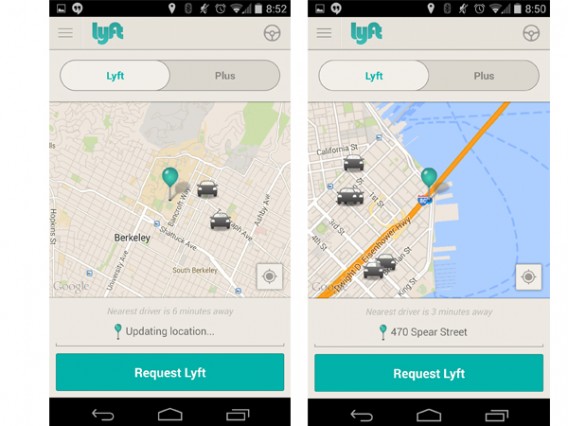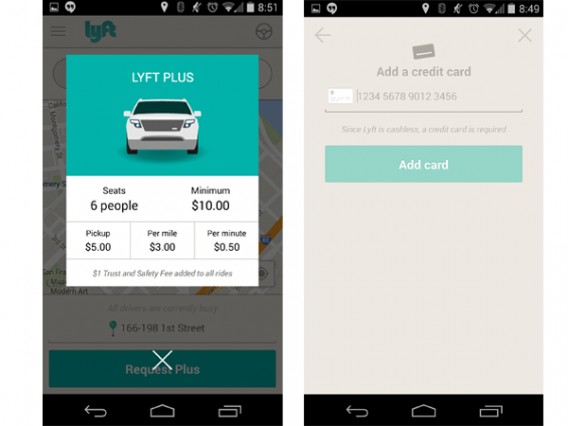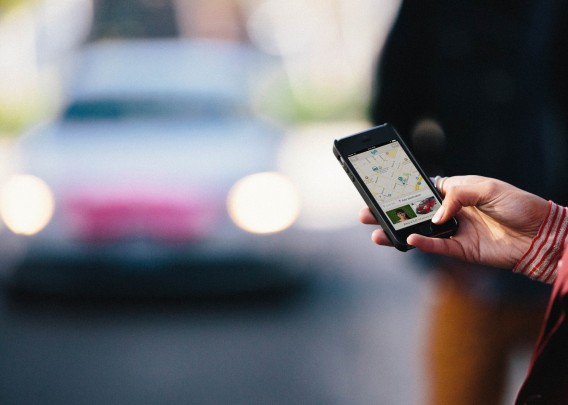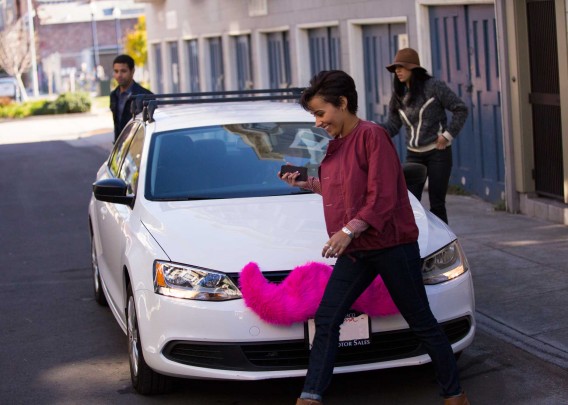The sharing economy is taking off, with everything from AirBnb to TaskRabbit seeing people opening their homes and offering their services to make a few extra bucks. Lyft falls into this category, a car-sharing app that lets people offer rides to help get others where they need to go quickly and economically, with the potential to meet people in the process.
Coincidentally, like fellow community app AirBnb and taxi app Uber, it’s stirring up some trouble for taking customers from local business while breaking some rules along the way. Is Lyft, however, simply another taxi app, or does it add something valuable that’s missing from the bottom line value of an industry?
Requesting a Lyft
As a mobile app for ride-sharing, Lyft takes a 21st century approach to hitchhiking, tacking an iconic pink mustache to the front of cars as a way to recognize Lyft drivers. With the app, you’ll find the closest pink mustachioed cars within your vicinity to pick you up and take you where you need to go.
If you need a ride, simply mark your location on the map with the teal balloon. Then, you’ll see all ‘Lyfts’ closest to you; hit the Request Lyft button, and you’ll be matched with the closest driver. While you’re waiting for the furry pink mustache to arrive, you can scan the driver’s profile to see exactly who’s coming to pick you up.

Each city sets a different price for Lyft, and after the trip, you’ll be able to pay within 24 hours of the ride – directly from and only using the app – with stored credit card details. Just like that, the driver will come and pick you up, and you’ve got a cheap ride from a friendly stranger. Within 24 hours, you also have the chance to rate the driver.

Logically, the app raises a few practical issues and concerns, which it has tried to address right from the beginning. Each Lyft car needs to undergo an in-person vehicle inspection, and each driver needs to complete a background check before they can start picking people up. On top of that, there’s $1 million in liability insurance, a factor that demonstrates Lyft’s commitment to safety.
At war in the city
From the outside looking in, it’s easy to see why cab drivers would get upset at a service like Lyft. It seems to offer almost everything a regular taxi app like Hailo–which works with a city’s existing taxi services– would, from the request, to the ratings system, to the mobile payments.

Another of its bigger draws, however, is the cost: it’s cheaper than regular taxi services, which is typically the case with other sharing-economy services like AirBnb and Task Rabbit.
While these services have so far proven to be a hit among users, it comes as no surprise that taxi drivers aren’t as enthusiastic about it.
Cabbies in New York City are the latest to kick up a fuss, where it’s still waiting to get permission to launch. The complaints come not only because of the potential business it’s taking from taxi drivers, but also because of strict New York laws, which point out that Lyft drivers aren’t using vehicles registered with the Taxi and Limousine Commission (TLC), and are operating with unlicensed commercial drivers.
It’s a battle we’ve seen before, especially in a city like New York. Both AirBnb and Uber faced legal issues in the Big Apple, where strict laws have put sanctions on the use of these services. Uber managed to cut a deal in New York, where it operates as a strictly commercial service with good standing among the TLC, while AirBnb is still dealing with the ‘illegall hotel law‘, which prohibits many people from renting out their places to holiday-goers.

The biggest problem Lyft faces now is convincing the TLC that it shouldn’t fit into the same category as a taxi-service. Lyft spokesperson Erin Simpson recently told the New York Times that they “do not believe its licensing and base stations rules apply to the Lyft ride-sharing model.”
The truth is, services like Lyft and AirBnb do offer much the same as commercial taxi and hotel services do, but there’s one added element that makes them more appealing than simply a cheaper alternative, and it could be a good indication of why they’ve been such a hit: personalization.
Personalization in the sharing economy
The difference that sets Lyft– and many of these ‘sharing economy’ services – apart, is a more personal experience with the opportunity to bring people together. The personal aspect of letting people into your car and the potential of making friends using the service isn’t something you’d normally get from a taxi service, just like staying in a hotel doesn’t give you the chance to experience local culture as intimately as renting a room from AirBnb would. This ‘personal touch’ is the hook, and it’s what differentiates these types of services from others. Lyft even has a section dedicated to stories of people who’ve met and remained friends using the service.
Ironically, what these apps and services bring, beyond some controversy and a cheaper alternative, is the personal element that’s been missing since the dawn of mobile phones, something that’s only getting worse as people continue to become more virtually, and less personally, connected. On top of that, services like Lyft, AirBnb, and TaskRabbit take away a lot of the formality and facelessness of conducting business, making it friendly and mutually beneficial: you get a cheap ride, the driver makes some extra cash, and you might even hit it off.
Apps like Lyft aren’t operating in a technological vacuum. It’s proven its potential for real world disruption, but even further, it’s bringing back human interaction to the service industry in a way that demonstrates that there’s still room for technology to bring people together not only in cyberspace, but on a more personal and real world level.
If you want to check out even more car-sharing apps, take a look at our article detailing 7 of the most popular ones out there.


